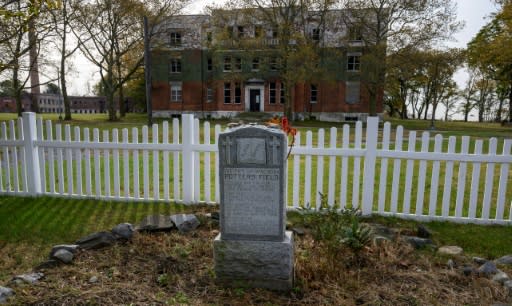New York's 'island of the dead' to welcome more of the living
A once off-limits, eroding island in New York where more than a million people are buried in unmarked mass graves dug by prisoners is about to become more accessible. For 150 years, unclaimed bodies, the poor, still-born children and AIDS victims have been laid to rest on the mile-long Hart Island, making it one of America's largest public cemeteries. Often referred to as "island of the dead" or "jail for the dead," the islet has for over a century been run by the prisons department, which heavily restricts access. Relatives are only allowed to visit on two designated days a month, while correctional officers escort media there just twice a year. AFP was on the most recent trip. "I don't want somebody to tell me when I can visit my baby's gravesite. I want to go when I want to go," Elaine Joseph, 65, told AFP. Her daughter Tomika was just a few days old when she died in January 1978 after being born prematurely. Joseph wasn't able to visit her burial place until 2014. Soon, the retired nurse will be able to pay her respects regularly thanks to plans to open up Hart Island, which Mayor Bill de Blasio signed on Wednesday. It is a major development in a years-long campaign to make the site, which has signs reading "prison property keep out," more dignified for the dead and their families. Hart Island, in the Long Island Sound tidal estuary, became a potter's field in 1869 after the city purchased it from a private landholder to bury unknown and indigent residents. Approximately 1,200 burials, some of unidentified people, still take place every year. Adults are buried in pine coffins stacked three deep; children five deep in plots of 1,000. The boxes are marked with numbers not names, and there are no gravestones. Small white markers indicating the trenches dot the island's burial grounds. - Exhumations - Inmates from nearby Rikers Island, one of America's most notorious jails, are paid $1 an hour to bury the dead. Around half of the interred are young children, officials say. Many HIV-positive people were buried on a separate site there during the 1980s AIDS crisis, after losing touch with their families or because private graveyards refused to take them over incorrect fears about contagion. Several nationalities are among the dead, including Chinese, Nigerian and Nepali people, notes Justin von Bujdoss, a prison chaplain who gave AFP a guided tour at the end of October. "Hart Island represents a cross section of the diversity of New York City, which is why it really ought to be considered sacred ground," he explained. Between 40 and 50 exhumations happen every year, according to officials, after relatives trace a loved one and opt to rebury them in a private cemetery. The island has served as a prison camp for captured Confederates in the US Civil War, a mental asylum, a sanatorium for tuberculosis sufferers, a youth detention center and even a Cold War-era missile base. Geese roam the windswept, low-lying island. Deer and raccoons are also present, while ospreys nest there and seals bob off its shore. The island is in need of an upgrade. Several dilapidated buildings lie abandoned and erosion, worsened by Superstorm Sandy in 2012, has damaged its shoreline, unearthing some bones. Archeologists have been handling remains to ensure bones do not get mixed up while this September work began on a $13.2 million project to mitigate the erosion. - 'Stigma' - Last month, New York's city council voted to end prison control of Hart Island by transferring jurisdiction to its parks department, in a move hailed by activists. It also pledged to start regular ferry services. "It lifts the stigma of city burials," Melinda Hunt, who has been campaigning for three decades to make the cemetery more accessible, told AFP. Hunt has helped countless relatives, including Joseph, trace their loved ones to Hart Island. Joseph's daughter died during a snowstorm that shut down New York. She was unable to get to the hospital and amid confusion the city buried the girl in its potter's field. Authorities first started permitting visits in 2007, although relatives were restricted to a gazebo away from the burial plots. After the city settled a lawsuit in 2015, relatives have been allowed to visit gravesites, albeit under controlled conditions and on the specified dates. Joseph has to apply to the prisons department for prior approval and is not allowed to use her cellphone or take any photos while there. Her visiting time is also limited. Once the transfer of jurisdiction is complete, expected in 2021, Joseph hopes to finally put up a plaque bearing her daughter's name, date of birth, and a small tribute to her. "I want it to be just like any other cemetery," she told AFP. White stones mark burial sites at the Potter's field on Hart Island in October 2019 in New York A memorial marker can be seen on the potter's field at Hart Island in October 2019 in New York New York Mayor Bill de Blasio signs legislation to make Hart Island a public park as Elaine Joseph (C behind de Blasio) Melinda Hunt (L) and Herbert Sweat (2nd L) watch in New York on December 4 A sign on the ferry dock warns against trespassing on the potter's field at Hart Island in October 2019 in New York




